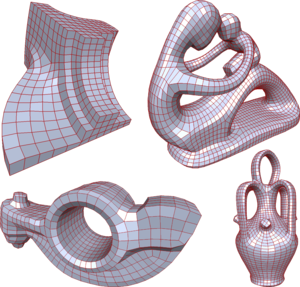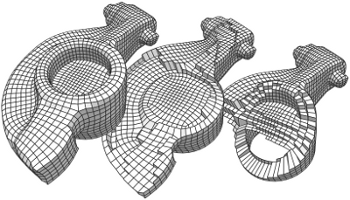Here are some examples of our current research projects. If you are interested in one of the topics please contact us by email for further detailed information and check out our publications page where you can find papers, software, and additional download material.

Remeshing algorithms are fundamental for the generation of high-quality CAD models in rapid prototyping, reverse engineering and conceptual design. Traditionally, remeshing algorithms where focused on improving the local mesh characteristics, i.e., on generating mesh elements with optimal shape and regularity (nearly quadratic). Recently the focus has widened to also incorporate structural considerations, i.e. the alignment of the elements to mesh features like edges and corners. We propose a two-step approach: In a first step the model is segmented into a set of (almost) planar regions that capture the overall structure of the model. In the second step, these regions are remeshed while taking consisteny constraints along their abutting boundaries into account. This way we obtain a high-quality, quad-dominant remesh that properly reflects the features of the input model.
See also our papers:

A purely topological approach for the generation of hexahedral meshes from quadrilateral surface meshes of genus zero has been proposed by M. Müller-Hannemann: in a first stage, the input surface mesh is reduced to a single hexahedron by successively eliminating loops from the dual graph of the quad mesh; in the second stage, the hexahedral mesh is constructed by extruding a layer of hexahedra for each dual loop from the first stage in reverse elimination order. In this paper, we introduce several techniques to extend the scope of target shapes of the approach and significantly improve the quality of the generated hexahedral meshes. While the original method can only handle "almost convex" objects and requires mesh surgery and remeshing in case of concave geometry, we propose a method to overcome this issue by introducing the notion of concave dual loops. Furthermore, we analyze and improve the heuristic to determine the elimination order for the dual loops such that the inordinate introduction of interior singular edges, i.e. edges of degree other than four in the hexahedral mesh, can be avoided in many cases.
See also our paper:
